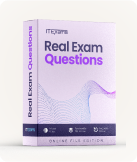IBM C9050-041 - Programming with IBM Enterprise PL/I Exam
Page: 1 / 30
Total 146 questions
Question #1 (Topic: Topic 1)
What is the most appropriate declaration for the variable X?
X = 1.123E+4;
X = 1.123E+4;
A. DCL X CHAR(4);
B. DCL X PIC '9999';
C. DCL X DEC FLOAT(16);
D. DCL X DEC FIXED(15,3);
Answer: C
Question #2 (Topic: Topic 1)
Which of the following describes when a program is NOT FETCHABLE?
A. When the main program need not be recompiled to reflect the changes made in the called program
B. When the called program will be loaded from the library at execution time
C. When the called program is part of the main program in the load module
D. When two main programs referring to the called program at the same time cannot have different versions of the called program
Answer: C
Question #3 (Topic: Topic 1)
What code needs to be executed, if any, before the variable A can be successfully
accessed?
DCL X PTR;
DCL B CHAR(100) INIT(' ');
DCL A CHAR(100) BASED(X);
accessed?
DCL X PTR;
DCL B CHAR(100) INIT(' ');
DCL A CHAR(100) BASED(X);
A. A can be accessed without any further action.
B. X = ADDR(B);
C. A = B;
D. X = NULL();
Answer: B
Question #4 (Topic: Topic 1)
What is the value of B after executing the following code?
DCL A CHAR(10) VAR;
DCL B BIN FIXED(31) INIT(0);
DCL C CHAR(5) INIT('ABCD');
A = C;
B = LENGTH(A);
DCL A CHAR(10) VAR;
DCL B BIN FIXED(31) INIT(0);
DCL C CHAR(5) INIT('ABCD');
A = C;
B = LENGTH(A);
A. 10
B. 7
C. 5
D. 4
Answer: C
Question #5 (Topic: Topic 1)
Given the following code, what will be output?
MP: PROC OPTIONS(MAIN);
DCL A CHAR(1) INIT('A');
DCL B CHAR(1) INIT('B');
DCL C CHAR(1) STATIC INIT('C');
CALL SR1(A);
PUT SKIP LIST(A!!B!!C);
SR1: PROC(A);
DCL A CHAR(1);
DCL B CHAR(1);
DCL C CHAR(1);
A = '1';
B = '2';
C = '3';
END SR1;
END;
MP: PROC OPTIONS(MAIN);
DCL A CHAR(1) INIT('A');
DCL B CHAR(1) INIT('B');
DCL C CHAR(1) STATIC INIT('C');
CALL SR1(A);
PUT SKIP LIST(A!!B!!C);
SR1: PROC(A);
DCL A CHAR(1);
DCL B CHAR(1);
DCL C CHAR(1);
A = '1';
B = '2';
C = '3';
END SR1;
END;
A. 1B3
B. 1BC
C. 123
D. 12C
Answer: B
